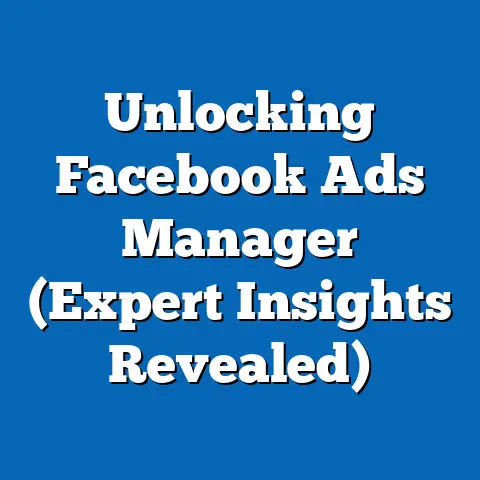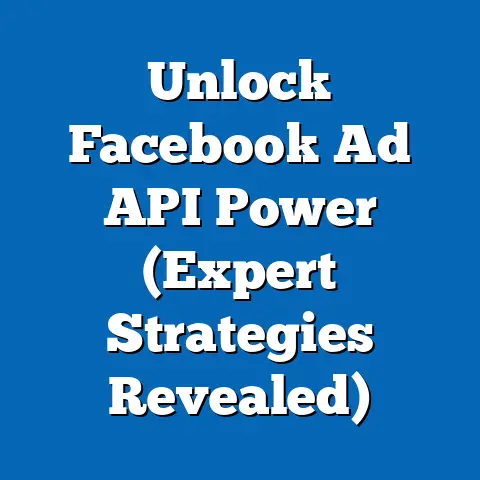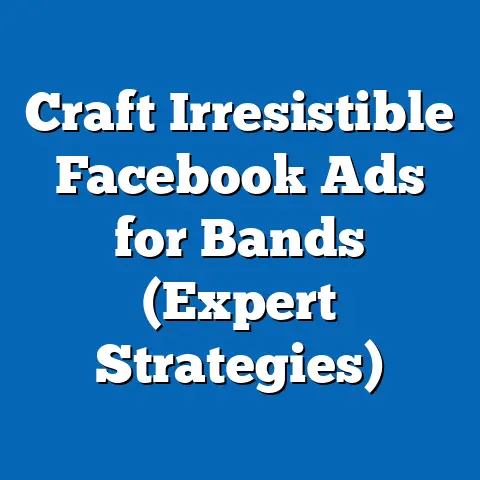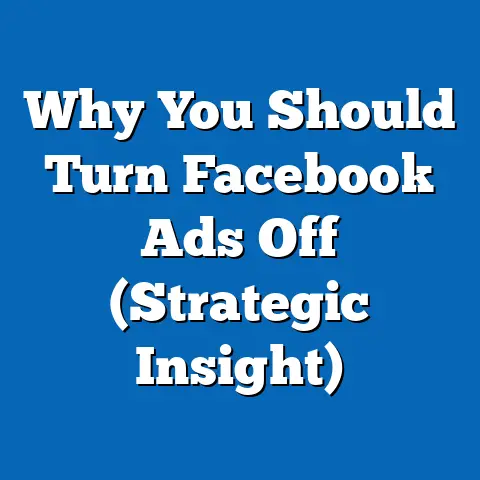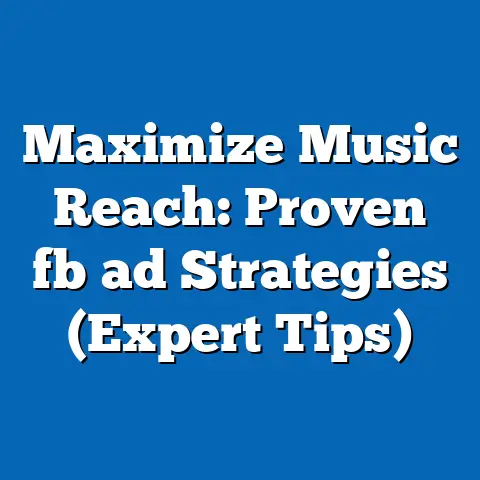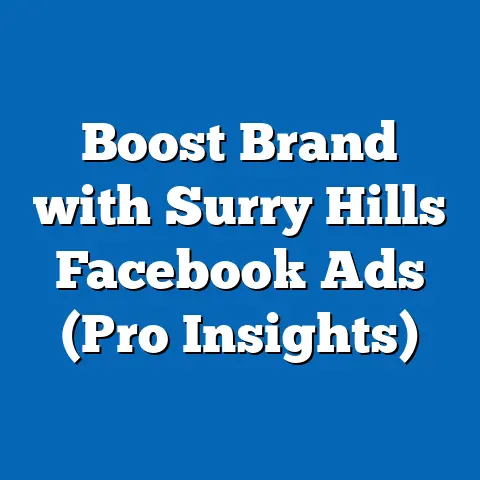Decode Facebook Ads Secrets (Expert Insights Unveiled)
Advertising. It’s a word that conjures up images of Mad Men, catchy jingles, and billboards that dominate the skyline. But the world of advertising has undergone a radical transformation, a digital revolution that has propelled us from the era of three-martini lunches to data-driven decisions and hyper-targeted campaigns. To truly understand the magnitude of this shift, let’s take a quick trip back in time.
Think back to the 1950s. Television was the shiny new toy, and advertisers were scrambling to figure out how to harness its power. Suddenly, brands could reach millions of homes with a single commercial. It was a game-changer, a seismic shift from radio and print. Fast forward to today, and that seismic shift looks more like a continuous series of aftershocks, each one driven by technological advancements.
Today, we live in an age where social media reigns supreme, and Facebook, in particular, holds a unique position. It’s not just a platform for sharing vacation photos and connecting with long-lost friends; it’s a powerhouse of advertising potential. Facebook seamlessly blends personal connection with incredibly sophisticated advertising tools, offering marketers the ability to reach highly specific audiences with tailored messages.
But here’s the catch: simply throwing money at Facebook ads isn’t a guaranteed path to success. It requires strategy, understanding, and a willingness to delve into the platform’s intricacies. That’s where “decoding” Facebook ads comes in. It’s about unraveling the complexities, understanding the algorithms, and leveraging expert insights to create campaigns that truly resonate with your target audience.
Over the years, I’ve seen countless businesses struggle with Facebook ads. Some treat it like a magic bullet, expecting instant results without putting in the work. Others are overwhelmed by the sheer number of options and features, unsure where to even begin. But I’ve also seen businesses achieve phenomenal success, using Facebook ads to drive sales, build brand awareness, and connect with customers on a deeper level. The difference? They understood the secrets, the nuances, the underlying principles that make Facebook advertising work.
In this article, I’m going to pull back the curtain and reveal those secrets. We’ll delve into the heart of the Facebook ads ecosystem, exploring everything from crafting compelling ad copy to mastering advanced targeting techniques. We’ll look at budgeting strategies, bidding options, and how to analyze your ad performance to continually optimize your campaigns.
So, buckle up, because we’re about to embark on a journey to decode the secrets of Facebook ads. Let’s get started!
Section 1: Understanding the Facebook Ads Ecosystem
The Facebook Ads Ecosystem can feel like a sprawling metropolis, filled with interconnected streets, bustling marketplaces, and hidden alleyways. To navigate it effectively, you need to understand its fundamental components and how they interact. Think of it as learning the layout of a new city before you try to drive through it during rush hour.
At its core, the Facebook Ads Ecosystem comprises several key elements:
- Ads Manager: This is your central command center, the control panel where you create, manage, and analyze your ad campaigns. It’s where you define your target audience, set your budget, design your ads, and track your performance. I like to think of it as the cockpit of your advertising aircraft; it’s where you control every aspect of your flight.
- Audience Insights: This powerful tool provides valuable data about your target audience, including their demographics, interests, behaviors, and purchase patterns. It’s like having a magnifying glass that allows you to examine your potential customers in detail, understanding their motivations and preferences.
- Ad Library: A treasure trove of information, the Ad Library allows you to see all the active ads running on Facebook and Instagram. It’s a fantastic resource for competitor analysis, inspiration, and identifying emerging trends. I often use it to see what other brands in my niche are doing and to get ideas for new ad creatives.
- Facebook Pixel: This is a snippet of code that you install on your website to track user behavior. It allows you to measure the effectiveness of your ads, optimize for conversions, and retarget visitors who have interacted with your website. Think of it as a digital tracker that follows your customers’ journey, providing you with valuable data about their interactions with your brand.
- Business Manager: This is a central hub for managing your Facebook pages, ad accounts, and other business assets. It allows you to grant access to team members, manage permissions, and keep everything organized. I find it essential for managing multiple clients and ensuring that everyone has the appropriate level of access.
Understanding user behavior on Facebook is paramount to achieving success with your ads. People use Facebook for a variety of reasons: to connect with friends and family, to discover new content, to stay informed about current events, and to be entertained. Your ads need to seamlessly integrate into this experience, providing value and capturing attention without feeling intrusive.
Think about your own experience on Facebook. What kind of ads do you notice? What kind of ads do you ignore? Chances are, you’re drawn to ads that are visually appealing, relevant to your interests, and offer something of value, whether it’s a discount, a helpful piece of information, or an entertaining video.
Facebook offers a wide range of ad formats, each with its own unique advantages:
- Image Ads: Simple yet effective, image ads are a great way to showcase your product or service with a visually appealing image and compelling copy. I often use image ads for brand awareness campaigns and to drive traffic to my website.
- Video Ads: Video ads are incredibly engaging and can be used to tell a story, demonstrate a product, or provide valuable information. They’re particularly effective for capturing attention in a crowded news feed. I’ve found that short, attention-grabbing videos tend to perform best.
- Carousel Ads: Carousel ads allow you to showcase multiple images or videos in a single ad unit. This format is ideal for highlighting different features of a product, telling a story, or showcasing a range of products. I’ve used carousel ads to showcase different angles of a product and highlight key benefits.
- Collection Ads: Collection ads are designed for e-commerce businesses and allow you to showcase a selection of products in a visually appealing format. When users click on a collection ad, they’re taken to a full-screen experience where they can browse and purchase products.
- Lead Ads: Lead ads make it easy for people to sign up for your email list, request a quote, or learn more about your products or services. They’re particularly effective for generating leads and building your customer base. I’ve used lead ads to collect email addresses for my newsletter and to offer free consultations.
- Instant Experience Ads (formerly Canvas Ads): These are full-screen, mobile-optimized ads that load instantly and provide a rich, immersive experience. They’re great for telling a story, showcasing a product in detail, or creating an interactive experience.
Facebook boasts a massive user base, with billions of active users worldwide. Understanding the demographics and engagement rates of this user base is crucial for effective advertising.
- Demographics: Facebook’s user base is incredibly diverse, spanning all age groups, genders, locations, and interests. Understanding the demographics of your target audience is essential for crafting relevant and effective ads.
- Engagement Rates: Facebook users are highly engaged, spending an average of [Insert Current Statistic] minutes per day on the platform. This high level of engagement provides advertisers with ample opportunity to reach their target audience and capture their attention.
- Mobile Usage: The vast majority of Facebook users access the platform via mobile devices. This means that your ads need to be optimized for mobile viewing, with clear visuals, concise copy, and fast loading times.
Key Takeaway: The Facebook Ads Ecosystem is a complex but powerful platform. Understanding its components, user behavior, ad formats, and demographics is essential for creating successful ad campaigns.
Next Steps: Take some time to explore the Ads Manager, Audience Insights, and Ad Library. Familiarize yourself with the different ad formats and consider how they might be used to achieve your advertising goals.
Section 2: Crafting Compelling Ad Copy
The soul of a Facebook ad, in my opinion, lies within its copy. You might have the most stunning visuals, the most laser-focused targeting, but if your words fail to resonate, your ad will fall flat. Think of it like a beautifully wrapped gift with nothing inside.
The psychology behind effective ad copywriting hinges on understanding what motivates people to take action. It’s about tapping into their desires, addressing their pain points, and offering them a solution that resonates with their needs.
Here are some key elements to consider:
- Headlines: Your headline is the first (and sometimes only) thing people will read. It needs to be attention-grabbing, concise, and relevant to your target audience. Think of it as the hook that reels them in.
- Example: Instead of “Learn More About Our Product,” try “Solve Your [Problem] in 5 Minutes with [Your Product].”
- Call-to-Action (CTA): Your CTA tells people what you want them to do. It needs to be clear, concise, and compelling. Use action verbs and create a sense of urgency.
- Example: Instead of “Click Here,” try “Shop Now and Get 20% Off!” or “Download Your Free Guide Today!”
- Emotional Triggers: People are more likely to take action when they feel an emotional connection to your message. Tap into their fears, desires, hopes, and dreams.
- Example: Instead of “Our Product is High-Quality,” try “Imagine [Benefit] with Our Product.”
- Value Proposition: Clearly communicate the value that your product or service offers. What problem does it solve? What benefits does it provide? Why should people choose you over the competition?
- Example: Instead of “We Sell Shoes,” try “Find the Perfect Shoes for Any Occasion and Experience Unmatched Comfort.”
- Social Proof: Leverage social proof to build trust and credibility. Include testimonials, reviews, and case studies to show that other people have had positive experiences with your brand.
- Example: “Join thousands of satisfied customers who have transformed their [Area] with our [Product].”
- Example: Instead of “Learn More About Our Product,” try “Solve Your [Problem] in 5 Minutes with [Your Product].”
- Example: Instead of “Click Here,” try “Shop Now and Get 20% Off!” or “Download Your Free Guide Today!”
- Example: Instead of “Our Product is High-Quality,” try “Imagine [Benefit] with Our Product.”
- Example: Instead of “We Sell Shoes,” try “Find the Perfect Shoes for Any Occasion and Experience Unmatched Comfort.”
- Example: “Join thousands of satisfied customers who have transformed their [Area] with our [Product].”
I’ve learned a lot from successful advertisers and copywriters over the years. One tip that has always stuck with me is to write like you’re talking to a friend. Use a conversational tone, avoid jargon, and focus on being authentic.
Here are some additional tips:
- Know Your Audience: Before you start writing, take the time to understand your target audience. What are their pain points? What are their aspirations? What language do they use?
- Keep it Concise: People have short attention spans, especially on social media. Get to the point quickly and avoid unnecessary fluff.
- Use Visuals: Pair your ad copy with compelling visuals that capture attention and reinforce your message.
- Test, Test, Test: Experiment with different headlines, CTAs, and ad copy to see what resonates best with your audience. A/B testing is your best friend in the world of Facebook Ads.
Let’s analyze some real-world examples of high-performing Facebook ads to see what makes them successful.
Example 1: Dollar Shave Club
- Visual: A humorous video featuring the company’s founder.
- Headline: Shave Time. Shave Money.
- CTA: Get Started.
- Key Elements: The ad uses humor to grab attention, clearly communicates the value proposition (saving time and money), and has a clear and concise CTA.
Example 2: Airbnb
- Visual: A stunning photo of a unique Airbnb property.
- Headline: Discover Unique Places to Stay.
- CTA: Explore Now.
- Key Elements: The ad uses a visually appealing image, taps into the desire for unique experiences, and has a CTA that encourages exploration.
Example 3: Monday.com
- Visual: A short video demonstrating the software’s features.
- Headline: Visualize Your Workflow and Get More Done.
- CTA: Get Started for Free.
- Key Elements: The ad clearly communicates the value proposition (visualizing workflow and increasing productivity), uses a video to demonstrate the software’s features, and has a CTA that offers a free trial.
Key Takeaway: Crafting compelling ad copy is essential for capturing attention, resonating with your target audience, and driving conversions. Focus on understanding your audience, communicating your value proposition, and using emotional triggers.
Next Steps: Review your existing Facebook ads and identify areas where you can improve your ad copy. Experiment with different headlines, CTAs, and emotional triggers to see what resonates best with your audience.
Section 3: Targeting Your Audience
Targeting your audience on Facebook is like having a laser-guided missile aimed at your ideal customer. It’s a far cry from the “spray and pray” approach of traditional advertising, where you cast a wide net and hope to catch a few fish. With Facebook’s targeting capabilities, you can pinpoint your audience with incredible precision, ensuring that your ads are seen by the people who are most likely to be interested in your products or services.
The beauty of Facebook advertising lies in its ability to reach specific demographics, interests, behaviors, and even custom audiences. This level of granularity allows you to tailor your message to the right people, maximizing your ad spend and increasing your chances of success.
Here’s a breakdown of the different targeting options available on Facebook:
- Demographics: Target people based on their age, gender, location, education, relationship status, and other demographic factors.
- Example: If you’re selling baby products, you can target parents with young children.
- Interests: Target people based on their interests, hobbies, and passions.
- Example: If you’re selling hiking gear, you can target people who are interested in hiking, camping, and the outdoors.
- Behaviors: Target people based on their online behavior, such as their purchase history, device usage, and travel habits.
- Example: If you’re selling luxury goods, you can target people who have a history of purchasing high-end products online.
- Custom Audiences: Create custom audiences based on your existing customer data, such as email lists, website visitors, and app users.
- Example: You can upload your email list to Facebook and target those customers with special offers or promotions.
- Lookalike Audiences: Expand your reach by targeting people who are similar to your existing customers.
- Example: You can create a lookalike audience based on your website visitors and target those people with ads.
- Example: If you’re selling baby products, you can target parents with young children.
- Example: If you’re selling hiking gear, you can target people who are interested in hiking, camping, and the outdoors.
- Example: If you’re selling luxury goods, you can target people who have a history of purchasing high-end products online.
- Example: You can upload your email list to Facebook and target those customers with special offers or promotions.
- Example: You can create a lookalike audience based on your website visitors and target those people with ads.
Creating buyer personas is a crucial step in the targeting process. A buyer persona is a fictional representation of your ideal customer, based on research and data about your existing customers. It helps you understand their motivations, pain points, and purchasing habits, allowing you to create more targeted and effective ads.
Here’s how to create a buyer persona:
- Gather Data: Collect data about your existing customers through surveys, interviews, and analytics.
- Identify Key Characteristics: Identify the key characteristics of your ideal customer, such as their age, gender, location, income, education, and interests.
- Create a Fictional Profile: Create a fictional profile that represents your ideal customer, giving them a name, a job, and a backstory.
- Define Their Pain Points: Identify the pain points that your ideal customer is experiencing. What problems are they trying to solve? What challenges are they facing?
- Understand Their Motivations: Understand what motivates your ideal customer. What are their goals? What are their aspirations?
- Tailor Your Message: Use your buyer persona to tailor your ad copy and visuals to resonate with your target audience.
Lookalike audiences are a powerful way to expand your reach and target new customers who are similar to your existing customers. Facebook uses its algorithm to identify people who share similar characteristics and behaviors with your source audience.
Here’s how to create a lookalike audience:
- Choose Your Source Audience: Select the source audience that you want to use to create your lookalike audience. This could be your website visitors, your email list, or your existing customers.
- Select Your Audience Size: Choose the size of your lookalike audience. A smaller audience will be more similar to your source audience, while a larger audience will be less similar.
- Create Your Lookalike Audience: Facebook will use its algorithm to identify people who share similar characteristics and behaviors with your source audience.
Let’s look at some case studies of brands that have successfully leveraged precise targeting to achieve their advertising goals.
Case Study 1: A Local Restaurant
- Goal: Increase reservations and drive more foot traffic.
- Targeting Strategy: Targeted people within a 5-mile radius of the restaurant, based on their interests in food, dining, and local restaurants.
- Results: Increased reservations by 20% and saw a significant increase in foot traffic.
Case Study 2: An E-commerce Business Selling Yoga Apparel
- Goal: Increase sales and build brand awareness.
- Targeting Strategy: Targeted people who were interested in yoga, fitness, and healthy living. Also created a lookalike audience based on their existing customers.
- Results: Increased sales by 30% and saw a significant increase in brand awareness.
Case Study 3: A Software Company Selling Project Management Tools
- Goal: Generate leads and drive free trials.
- Targeting Strategy: Targeted people who worked in project management, marketing, and software development. Also created a custom audience based on their website visitors and targeted them with retargeting ads.
- Results: Increased leads by 25% and saw a significant increase in free trials.
Key Takeaway: Targeting your audience on Facebook is crucial for maximizing your ad spend and achieving your advertising goals. Take the time to understand your target audience, create buyer personas, and leverage the different targeting options available on Facebook.
Next Steps: Review your existing Facebook ad campaigns and evaluate your targeting strategies. Are you targeting the right people? Are you using the most effective targeting options? Consider creating buyer personas and experimenting with lookalike audiences to expand your reach.
Section 4: Budgeting and Bidding Strategies
Navigating the world of Facebook Ads budgeting and bidding can feel like walking through a financial maze. There are so many options, strategies, and potential pitfalls that it’s easy to get lost. But fear not! With a clear understanding of the fundamentals and some expert guidance, you can optimize your ad spend and maximize your ROI.
Facebook offers two main budgeting options:
- Daily Budget: This is the average amount you’re willing to spend on your ad campaign each day. Facebook will try to spend this amount each day, but it may fluctuate slightly depending on the performance of your ads.
- Lifetime Budget: This is the total amount you’re willing to spend on your ad campaign over its entire duration. Facebook will try to spread your budget evenly over the campaign’s lifetime, but it may adjust the daily spend based on performance.
The choice between a daily budget and a lifetime budget depends on your campaign goals and your level of control. If you want to have more control over your daily spend, a daily budget is a good option. If you want to set a total budget and let Facebook optimize the spend over time, a lifetime budget is a better choice.
Facebook offers several bidding strategies, each designed to achieve different campaign objectives:
- Cost Per Click (CPC): You pay each time someone clicks on your ad. This strategy is best for driving traffic to your website or landing page.
- Cost Per Mille (CPM): You pay for every 1,000 impressions your ad receives. This strategy is best for brand awareness campaigns and reaching a large audience.
- Cost Per Action (CPA): You pay only when someone takes a specific action, such as making a purchase or signing up for a newsletter. This strategy is best for driving conversions and generating leads.
- Lowest Cost: Facebook automatically bids to get you the most results for your budget. This strategy is best for beginners and for campaigns where you’re not sure what bidding strategy to use.
- Target Cost: You set a target cost per result, and Facebook tries to get you results at or below that cost. This strategy is best for campaigns where you have a specific cost target in mind.
- Bid Cap: You set a maximum bid that you’re willing to pay for each result. This strategy is best for campaigns where you want to control your costs and prevent overspending.
Choosing the right bidding strategy depends on your campaign objectives and your budget. If you’re trying to drive traffic to your website, CPC is a good option. If you’re trying to build brand awareness, CPM is a better choice. If you’re trying to drive conversions, CPA is the best option.
Here are some insights from experts on how to optimize your ad spend and maximize your ROI:
- Start Small: Don’t start with a huge budget. Start small and gradually increase your spend as you see results.
- Test, Test, Test: Experiment with different ad creatives, targeting options, and bidding strategies to see what works best for your audience.
- Monitor Your Performance: Regularly monitor your ad performance and make adjustments as needed.
- Use Retargeting: Retargeting ads are a great way to reach people who have already interacted with your brand.
- Optimize Your Landing Page: Make sure your landing page is optimized for conversions.
- Use Conversion Tracking: Use conversion tracking to measure the effectiveness of your ads.
Here are some tips on tracking your ad performance and making data-driven decisions to adjust your budgets and bids:
- Use Facebook Analytics: Facebook Analytics provides detailed data about your ad performance, including impressions, clicks, conversions, and cost per result.
- Use Google Analytics: Google Analytics provides data about your website traffic and user behavior.
- Track Your ROI: Track your return on investment (ROI) to measure the profitability of your ad campaigns.
- A/B Test Everything: A/B test different ad creatives, targeting options, and bidding strategies to see what works best for your audience.
- Make Data-Driven Decisions: Use the data you collect to make informed decisions about your budgets and bids.
Key Takeaway: Budgeting and bidding strategies are crucial for maximizing your ROI on Facebook ads. Understand the different budgeting options and bidding strategies available, and choose the ones that are best suited for your campaign objectives.
Next Steps: Review your existing Facebook ad campaigns and evaluate your budgeting and bidding strategies. Are you using the right budgeting options? Are you using the most effective bidding strategies? Consider experimenting with different strategies to see what works best for your audience.
Section 5: Analyzing Ad Performance
Analyzing ad performance is the compass that guides your Facebook advertising journey. Without it, you’re sailing blindly, unsure if you’re heading in the right direction. It’s about more than just looking at vanity metrics; it’s about understanding the story that the data is telling you and using that information to optimize your campaigns for better results.
Key Performance Indicators (KPIs) are the metrics that you should track to measure the success of your campaigns. These KPIs will vary depending on your campaign objectives, but here are some of the most common ones:
- Impressions: The number of times your ad was shown to people. This is a good indicator of your reach and brand awareness.
- Reach: The number of unique people who saw your ad. This is another good indicator of your reach and brand awareness.
- Clicks: The number of times people clicked on your ad. This is a good indicator of engagement and interest.
- Click-Through Rate (CTR): The percentage of people who saw your ad and clicked on it. This is a good indicator of the relevance and effectiveness of your ad copy and visuals.
- Cost Per Click (CPC): The average cost you paid for each click on your ad. This is a good indicator of the efficiency of your ad spend.
- Conversions: The number of people who took a desired action after seeing your ad, such as making a purchase or signing up for a newsletter. This is the ultimate measure of your campaign’s success.
- Cost Per Conversion (CPA): The average cost you paid for each conversion. This is a good indicator of the efficiency of your ad spend in driving conversions.
- Return on Ad Spend (ROAS): The amount of revenue you generated for every dollar you spent on advertising. This is the ultimate measure of your campaign’s profitability.
A/B testing, also known as split testing, is a powerful technique for comparing two versions of an ad to see which one performs better. It involves creating two identical ads with one variation, such as a different headline, image, or CTA, and then running them simultaneously to see which one generates more clicks, conversions, or other desired outcomes.
Here’s how to conduct an A/B test:
- Identify a Variable: Choose one variable that you want to test, such as the headline, image, or CTA.
- Create Two Versions: Create two versions of your ad with the variable you’ve chosen.
- Run the Test: Run the two ads simultaneously, making sure they have the same targeting options and budget.
- Analyze the Results: Analyze the results of the test to see which version performed better.
- Implement the Winner: Implement the winning version of the ad in your campaign.
There are many tools and techniques you can use to analyze your ad performance data. Here are some of the most popular ones:
- Facebook Analytics: Facebook Analytics provides detailed data about your ad performance, including impressions, clicks, conversions, and cost per result.
- Google Analytics: Google Analytics provides data about your website traffic and user behavior.
- Spreadsheets: You can use spreadsheets to track your ad performance data and create custom reports.
- Data Visualization Tools: Data visualization tools, such as Tableau and Power BI, can help you create interactive dashboards and reports to visualize your ad performance data.
Interpreting analytics reports and making informed adjustments to your campaigns based on insights gained is a critical skill for any Facebook advertiser. Here are some tips:
- Look for Trends: Look for trends in your data to identify patterns and insights.
- Segment Your Data: Segment your data to see how different segments of your audience are responding to your ads.
- Identify Underperforming Ads: Identify ads that are underperforming and make adjustments to improve their performance.
- Focus on ROI: Focus on maximizing your return on investment (ROI) by optimizing your ad spend and improving your conversion rates.
- Stay Up-to-Date: Stay up-to-date with the latest Facebook advertising trends and best practices.
Key Takeaway: Analyzing ad performance is essential for optimizing your Facebook ad campaigns and achieving your advertising goals. Track your KPIs, conduct A/B tests, and use the data you collect to make informed adjustments to your campaigns.
Next Steps: Review your existing Facebook ad campaigns and analyze your ad performance data. Are you tracking the right KPIs? Are you conducting A/B tests? Are you using the data you collect to make informed adjustments to your campaigns?
Conclusion
We’ve covered a lot of ground in this article, delving into the intricate world of Facebook advertising and uncovering some of its most valuable secrets. From understanding the Facebook Ads Ecosystem to crafting compelling ad copy, targeting your audience effectively, mastering budgeting and bidding strategies, and analyzing ad performance, you now have a solid foundation for creating successful Facebook ad campaigns.
I hope this guide has provided you with a deeper understanding of the complexities of Facebook advertising and empowered you with the knowledge and tools you need to achieve your advertising goals. Remember, the key to success lies in continuous learning, experimentation, and a willingness to adapt to the ever-changing landscape of digital marketing.
As we discussed at the beginning of this article, advertising has evolved dramatically over the years, from the early days of television to the data-driven world of social media. Understanding this historical context is crucial for appreciating the power and potential of Facebook advertising.
By combining expert knowledge, analytical skills, and a strategic approach, you can unlock the true potential of Facebook ads and drive significant results for your business. Don’t be afraid to experiment, test new ideas, and learn from your mistakes. The most successful advertisers are those who are constantly learning and adapting to the changing landscape.
So, take action! Apply the insights you’ve gained from this article to your advertising strategies, and position yourself for success in the competitive world of digital marketing. The future of advertising is here, and it’s waiting for you to decode its secrets and unlock its full potential.

